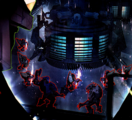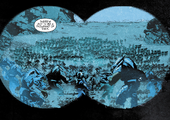Ariel
From Halopedia, the Halo wiki
| Ariel | |
|---|---|

| |
| Physical | |
|
Atmosphere: |
Breathable[1] |
| Societal | |
|
Species: |
|
|
Population: |
4,000[1] |
|
Government: |
|
Ariel is a human colony world in the 26th-century. The planet is a remote, barren world with two archaeological dig sites and one settlement, with a population of approximately 4,000 residents.[1] The colony also housed an ONI Section Three laboratory.[2]
History
Ancient history
During the height of the Forerunner civilization, they built an underground complex on Ariel. The facility housed The Knowing, an AI construct designed to observe and archive information. The entrance to the facility was defended by booby traps consisting of crisscrossing laser beams.[3]
Human-Covenant War
In 2532, the ONI rerouted several chemical precursors used in the SPARTAN-II augmentation procedures to the Section III lab on Ariel, along with similar facilities on other colonies, likely to serve as the basis for the SPARTAN-III augmentations.[2]
At some point during the Human-Covenant War, rumors originating on Ariel emerged of advanced Mark IV MJOLNIR armor prototypes with the architecture for energy shields.[4]
In January 2552, the Covenant invaded the colony, and one of the civilians managed to send out a distress signal, to which UNSC High Command responded with sending a force of Orbital Drop Shock Troopers from the 105th ODST Division to investigate. The UNSC forces came to notice that the Covenant were not operating in their usual fashion: glassing of the planet was not their intent, but they were searching for something under the surface instead.[1]
The object the Covenant sought was discovered to be the Forerunner AI. Shortly after being found by the ODST squad, it self-destructed on the orders of ODST Kojo Agu. As a result, the Covenant fleet broke off their attack, not even wasting the energy required to glass the planet.[3]
Trivia
- Ariel is also the name of the planet Uranus' fourth largest moon.
- Ariel is also the name of a planet in the television series Firefly, which starred the voice actors for Buck, Dutch and Mickey (being Nathan Fillion, Adam Baldwin and Alan Tudyk, respectively).
Gallery
List of appearances
- Halo: Helljumper (First appearance)
- Halo 3: ODST Pre-mission Evaluation (Mentioned only)
- Halo: Reach
- Dr. Halsey's personal journal (Mentioned only)
Sources
- ^ a b c d e Halo: Helljumper, issue #1
- ^ a b Dr. Halsey's personal journal, January 18, 2532
- ^ a b Halo: Helljumper, issue #5
- ^ Halo Encyclopedia (2009 edition),



